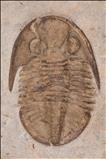This is the only Permian trilobite I have. It is the youngest (and thus latest) trilobite I have. It is instructive to consider the world it lived in and contrast it to the world that Archaeaspis_macropleuron, my oldest (and earliest) trilobite lived in.
When Archaeaspis macropleuron lived during the early Atdabanian (3rd stage of the Cambrian) trilobites were as advanced as any other living thing. With antennae, eyes, and legs, they could move about and sense the world in a way that what was then the state of the art for animals. Our own phylum, the chordates, was represented by at best very primitive jawless fish, one step up from chordate worms. They were no threat to adult trilobites and nobody would have bet that that phylum would ever amount to anything much. The most advanced land "plants" were lichens (symbiotic combinations of fungi and algae or cyanobacteria).
When this trilobite lived the marine ecological niches formerly held by trilobites were largely taken over by crustaceans. Jawed fish had become the dominant type of fish during the Devonian and by the Permian the Actinopterygian (ray finned) fish were already the dominant type of fish (they have become more dominant since). On land vascular plants grew everywhere the ground was wet enough and there were great forests over much of the land. There were early conifers and tree ferns, although flowering plants were still far into the future. Tetrapods had evolved during the Devonian, and by the Permian large Temnospondyl amphibians haunted the swamps, and on dryer land there were early reptiles. When this trilobite lived the peak of trilobite diversity, at the end of the Cambrian and beginning of the Ordovician, was 200 million years in the past. The last time of significant trilobite diversity, the Middle Devonian, was 100 million years in the past. The world was becoming modern and this trilobite was a relic of an ancient past. 30 million years after it lived trilobites winked out of existence entirely during the great end Permian mass extinction.

